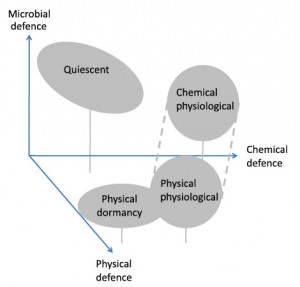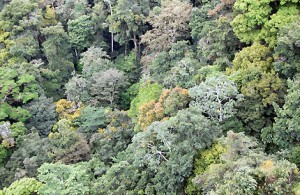
Schematic illustration of the predicted positioning of different dormancy types along axes describing seed investment in physical and chemical defenses, and defenses provided by seed-associated microbial mutualists. From Dalling et al. 2011.
Although seed plants encompass a wide array of reproductive strategies, the majority that rely at least in part on seeds for recruitment must ensure that their seeds successfully persist in soil prior to germination, thus relying on either quiescence or dormancy. Despite numerous studies of seed persistence in a variety of ecosystems, no unifying framework links mechanisms of persistence to the biotic context in which they operate. Our objective is to understand the relationship between seed persistence and defense mechanisms in the context of mechanisms of seed dormancy and interactions with the soil microbial community. More specifically, we will test the predictions of a ‘dormancy-defense’ conceptual framework (Dalling et al. 2011) through a large-scale seed burial and recovery experiment, coupled with bioassays, inoculation trials, and characterization of seed-associated fungi in a lowland tropical forest.

Tropical forest trees have a variety of strategies for allowing seeds to persist in soil. Our project evaluates predictions based on these strategies, with the goal of defining seed defense syndromes. Photo credit: JWD.
Our research is based at the Smithsonian Tropical Research Institute, the University of Illinois Urbana-Champaign, the University of Arizona, and the USDA-ARS Global Change and Photosynthesis Research Unit. We are supported by the National Science Foundation.

